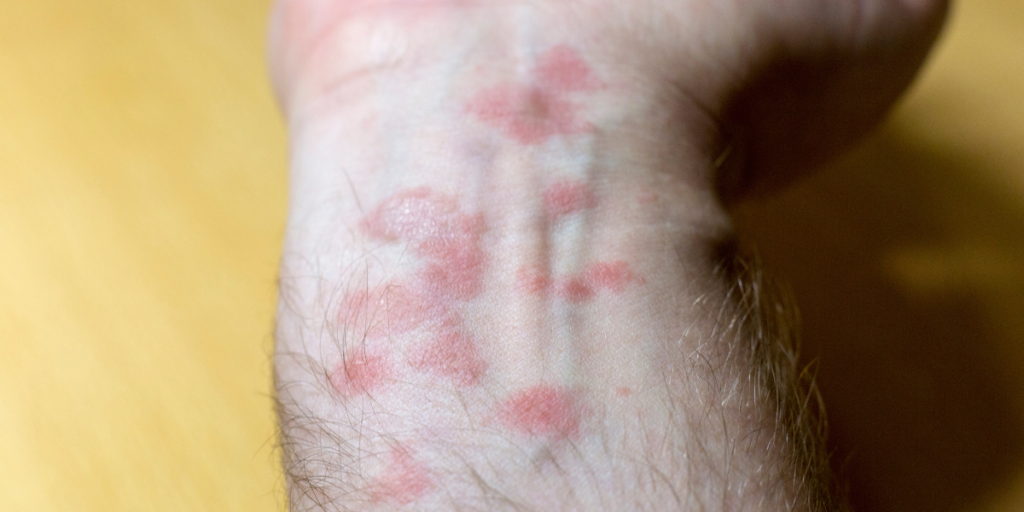Tick-borne diseases can pose a significant risk to both outdoor and indoor workers, making it crucial for employers and HR professionals to be vigilant and aware of potential dangers like Rocky Mountain Spotted Fever (RMSF). By understanding the alarming implications of this disease, its potential impact on your workforce, and the preventive measures that can be taken, you can create a work environment that prioritizes the health and safety of your employees. Let’s explore the severity of RMSF, its causes, commonly observed symptoms, and most importantly, effective strategies to minimize the risk of transmission.
Staff an OnSite Health Nurse and Save
>>Click Here for our ROI of On-site Nurses Flyer<<
What is Rocky Mountain Spotted Fever?
Rocky Mountain Spotted Fever (RMSF) is a tick-borne disease caused by the bacterium Rickettsia rickettsii. It is primarily transmitted through tick bites, as ticks become infected by feeding on animals carrying the bacteria. While RMSF is commonly associated with the Rocky Mountain region, it can occur in various parts of the United States. According to the CDC reports, every year, approximately 4,000 to 6,000 tickborne spotted fevers, including RMSF, are reported in the United States. It is concerning to note that more than 60% of the reported RMSF cases occur in five states: North Carolina, Tennessee, Oklahoma, Arkansas, and Missouri.
Symptoms and Early Detection
- Fever
- Headache
- Rash
- Nausea
- Vomiting
- Stomach pain
- Muscle aches
The key indicator of RMSF is the development of a characteristic rash which usually develops 2-4 days after the fever starts. The appearance of the rash can vary widely, with some rashes resembling red splotches and others appearing as pinpoint dots. While almost all people with RMSF will develop a rash, it often does not appear early in the illness, making it difficult to diagnose. If you experience symptoms like fever, headache, muscle aches, and nausea, it is important to seek medical attention, even without the presence of a rash.

Dangers and Complications of Rocky Mountain Spotted Fever
Delayed or inadequate treatment of RMSF can lead to severe complications. The bacteria can damage blood vessels and affect organ function. This can result in complications such as altered mental status, respiratory problems, tissue necrosis, multiorgan damage, and even renal failure. Certain populations, such as children and individuals with G6PD deficiency, are at a higher risk for complications. While these populations are identified as being at a higher risk, it is important to note that anyone can be affected by RMSF, and early diagnosis and treatment are crucial for favorable outcomes.
Prevention Measures
Preventing RMSF begins with you! There are simple things you can do and encourage the people around you to do when spending time outdoors, especially in tick-prone areas:
- Wear appropriate clothing (long sleeves, long pants, closed-toe shoes) in tick-prone areas
- Use insect repellents containing DEET
- Conduct thorough tick checks after outdoor activities
- Provide education about the importance of tick removal
Early Detection and Treatment
Having an on-site nurse or medical professional available is beneficial in facilitating early detection and treatment of Rocky Mountain Spotted Fever. They will provide immediate medical assessment to make sure employees receive the care they need.
An on-site nurse or medical professional can offer several advantages in managing RMSF:
Immediate evaluation
With an on-site medical professional, employees can receive prompt evaluation if they develop symptoms of RMSF. The nurse or medical professional can assess the severity of symptoms and provide guidance on the next steps, such as seeking further medical care or administering first aid measures.
Treatment administration
On-site medical professionals can administer first-line antibiotics as soon as RMSF is suspected, even before an official diagnosis is made. This helps prevent the disease’s progression and reduce the risk of complications.
Continuous monitoring
An on-site nurse or medical professional can provide ongoing monitoring for employees diagnosed with RMSF or those who have been exposed to tick bites. They can keep track of symptoms, provide support during recovery, and help employees follow the recommended treatment plan.
Education and training
On-site medical professionals can also offer education and training on tick prevention, recognizing early symptoms of RMSF, and the importance of prompt treatment. They can conduct training sessions for employees, distribute informational materials, and raise awareness about the disease.
OnSite Health: Helping You Protect Your Employees
Employers and HR professionals need to have a strong understanding of Rocky Mountain Spotted Fever (RMSF) and take necessary preventive measures to protect their employees. OnSite Health provides valuable on-site nursing services and clinics that offer immediate evaluation, treatment, monitoring, and education. By partnering with OnSite Health, you can enhance your ability to manage RMSF and create a safe and healthy working environment for your employees. Don’t hesitate to contact us today for more information and to take proactive steps towards safeguarding your workforce against tick-borne illnesses like RMSF.

